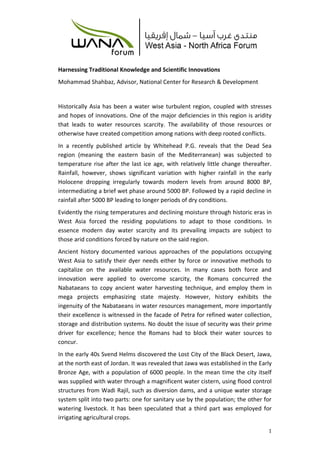
Shahbaz - Harnessing Traditional Knowledge and Scientific Innovations
- 1. Harnessing Traditional Knowledge and Scientific Innovations Mohammad Shahbaz, Advisor, National Center for Research & Development Historically Asia has been a water wise turbulent region, coupled with stresses and hopes of innovations. One of the major deficiencies in this region is aridity that leads to water resources scarcity. The availability of those resources or otherwise have created competition among nations with deep rooted conflicts. In a recently published article by Whitehead P.G. reveals that the Dead Sea region (meaning the eastern basin of the Mediterranean) was subjected to temperature rise after the last ice age, with relatively little change thereafter. Rainfall, however, shows significant variation with higher rainfall in the early Holocene dropping irregularly towards modern levels from around 8000 BP, intermediating a brief wet phase around 5000 BP. Followed by a rapid decline in rainfall after 5000 BP leading to longer periods of dry conditions. Evidently the rising temperatures and declining moisture through historic eras in West Asia forced the residing populations to adapt to those conditions. In essence modern day water scarcity and its prevailing impacts are subject to those arid conditions forced by nature on the said region. Ancient history documented various approaches of the populations occupying West Asia to satisfy their dyer needs either by force or innovative methods to capitalize on the available water resources. In many cases both force and innovation were applied to overcome scarcity, the Romans concurred the Nabataeans to copy ancient water harvesting technique, and employ them in mega projects emphasizing state majesty. However, history exhibits the ingenuity of the Nabataeans in water resources management, more importantly their excellence is witnessed in the facade of Petra for refined water collection, storage and distribution systems. No doubt the issue of security was their prime driver for excellence; hence the Romans had to block their water sources to concur. In the early 40s Svend Helms discovered the Lost City of the Black Desert, Jawa, at the north east of Jordan. It was revealed that Jawa was established in the Early Bronze Age, with a population of 6000 people. In the mean time the city itself was supplied with water through a magnificent water cistern, using flood control structures from Wadi Rajil, such as diversion dams, and a unique water storage system split into two parts: one for sanitary use by the population; the other for watering livestock. It has been speculated that a third part was employed for irrigating agricultural crops. 1
- 2. Those inherent water resources management practices formed a knowledge platform still widely used by communities and individuals, modern terminology defines it as “Traditional Knowledge”. Although those models are based on trial and error withstanding the test of time are valid in application. Generations after generations made use of this knowledge to the advantage of their communities, perhaps with modifications as they come. The living example today is the Marib Dam, “the site of the great dam (Sudd Marib) is upstream (south-west) of the ancient city of Marib, once the capital of the Kingdom of Saba'a, believed to be the kingdom of the legendary Queen of Sheba. The Kingdom of Saba'a was a prosperous trading nation, with control of the frankincense and spice routes in Arabia and Abyssinia. The Sabaens built the dam to capture the periodic monsoon rains which fall on the nearby mountains and so irrigate the land around the city. Recent archaeological findings suggest that simple earth dams and a canal network were constructed as far back as 2000 BC. The building of the first Marib dam began somewhere between 1750 BC and 1700 BC”. Evidently the modern dam was built by the Yamani government in the vicinity based on the profound ancient site selection criteria for the same purpose. In conclusion of the traditional knowledge section a scientific based integrated effort should be placed in the WANA region, to elaborate on the documentation of the exceedingly rich heritage in water resources management practices. Capitalizing on the lessons learned and adding knowledge to the modern science base. Innovation existed since the creation of mankind, purposefully serving as the platform for human civilization progress ever since. Innovation and innovators are always there, but need the appropriate incubation to lead them forward. One witnesses the excelling domestic human resources leaking to the industrial world without any return due failures in the support systems: no adaption, no incentives, and short comings in the legal frameworks leading to frustration. Innovation is driven by creativity and originality from childhood in individuals, fostered by a profound inventive culture in the society, characterized by precision and endurance. In modern societies with advanced thinking appropriate systems are formulated to embody such individuals that have exceptional performances leading to innovation. Such initiative must be capitalized upon in our societies if a positive change is desired. The essence of this change must target youth with objective programs, programs that include adoption of distinguished individuals with the following potential: 2
- 3. 1. Curiosity that is associated with problem solving, 2. Inclination towards exploration and detection, 3. Brilliance, 4. Imagination, 5. Dedication, 6. Resourcefulness, 7. Independence, and 8. Adventurous. The incentive within such a framework is preservation and protection of patency rights, a key factor that needs much improvement in our governing systems. The appropriate recognition (patents) of those innovators is the enabling environment, which provides security and incentive; further more it feeds the wheels of development to reach new heights for better future. 3
